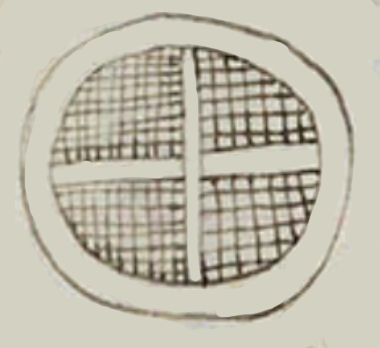cedazo (CST32)
This painting of the simplex glyph for the term cedazo (flour sieve) shows a circle with an outer border in white and a cross (+) inside the border. The result is, probably coincidentally, a quincunx shape. Each quadrant of the interior has a mesh pattern. This technology is European, which is suggested by the loanword and the look of the sieve, which may be made with metal mesh in a framework. But there is a term in Nahuatl that appears to be parallel to cedazo, and this is tlatzetzeloloni. Perhaps the latter is a neologism. See: Kevin Terraciano, Codex Sierra (2021), 120, 154, and 206.
Stephanie Wood
cedaços
cedazos
Stephanie Wood
1550–1564
Jeff Haskett-Wood
tamiz, tamices, cedazos, cernedores, separadores, harina de trigo

cedazo (a loanword from Spanish), a sieve, https://nahuatl.wired-humanities.org/content/cedazo
tlatzetzeloloni, a separator or perhaps a sifter, https://nahuatl.wired-humanities.org/content/tlatzetzeloloni
tex(tli), flour, https://nahuatl.wired-humanities.org/content/textli
cedazo
Stephanie Wood
Códice Sierra-Texupan, plate 32, page dated 1560. Origin: Santa Catalina Texupan, Mixteca Alta, State of Oaxaca. Kevin Terraciano has published an outstanding study of this manuscript (Codex Sierra, 2021), and in his book he refers to alphabetic and “pictorial” writing, not hieroglyphic writing. We are still counting some of the imagery from this source as hieroglyphic writing, but we are also including examples of “iconography” where the images verge on European style illustrations or scenes showing activities. We have this iconography category so that such images can be fruitfully compared with hieroglyphs. Hieroglyphic writing was evolving as a result of the influence of European illustrations, and even alphabetic writing impacted it.
https://bidilaf.buap.mx/objeto.xql?id=48281&busqueda=Texupan&action=search
The Biblioteca Digital Lafragua of the Biblioteca Histórica José María Lafragua in Puebla, Mexico, publishes this Códice Sierra-Texupan, 1550–1564 (62pp., 30.7 x 21.8 cm.), referring to it as being in the “Public Domain.” This image is published here under a Creative Commons license, asking that you cite the Biblioteca Digital Lafragua and this Visual Lexicon of Aztec Hieroglyphs.




